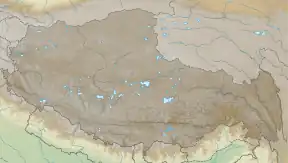| Dagze Lake | |
|---|---|
 | |
 Dagze Lake | |
| Location | Xainza County, Nagqu, Tibet, China |
| Coordinates | 31°53′41″N 87°30′29.9″E / 31.89472°N 87.508306°E |
| Type | Meromictic lake[1] |
| Surface area | 260 km2 (100 sq mi) |
Dazecuo (also known as Dagze Lake,[2] Tibetan: སྟག་རྩེ་མཚོ, Wylie: stag rtse mtsho, THL: tak tsé tso, ZYPY: Dagzê Co; Chinese: 达则错; pinyin: Dázécuò) is one of many inland lakes in Tibet. It is a salt lake on the Tibetan Plateau[3] in Xainza County within Nagqu in the Tibet Autonomous Region of China. It was reported in 2021 that the lake receives "good environmental protection".[4]
It has an area of 260 km² (100 square miles) and an elevation of 4,459 meters above sea level.[4] In 2021 the lake was 21.1 kilometers in length and 16.9 kilometers wide.[4]
In glacial times, the region was considerably wetter, and lakes were correspondingly much larger. Changes in climate have resulted in greater aridity on the Tibetan Plateau. The numerous concentric rings that circle the lake are fossil shorelines, and attest to the historical presence of a larger, deeper lake.[2]
See also
References
- ↑ Wang, M., Hou, J. and Lei, Y., 2014. Classification of Tibetan lakes based on variations in seasonal lake water temperature. Chinese Science Bulletin, 59(34): 4847-4855.
- 1 2 "EO Newsroom: New Images - Dagze Co, Tibet". earthobservatory.nasa.gov. February 18, 2003. Archived from the original on February 18, 2003. Retrieved May 19, 2022.
{{cite web}}: CS1 maint: unfit URL (link) - ↑ Qin, Huayu; Wang, Shang; Feng, Kai; He, Zhili (May 2019). "Unraveling the diversity of sedimentary sulfate-reducing prokaryotes (SRP) across Tibetan saline lakes using epicPCR". Microbiome, 7(1). doi:10.1186/s40168-019-0688-4
- 1 2 3 "Plateau lakes in Tibet with an altitude of more than 4,400 meters Dazecuo: good ecology and beautiful scenery". China News Agency. July 29, 2021. Retrieved May 16, 2022.
Further reading
- Huang, Sijun; Liu, Yongqin; Hu, Anyi; Liu, Xiaobo; Chen, Feng; Yao, Tandong; Jiao, Nianzhi (August 25, 2009). "Genetic Diversity of Picocyanobacteria in Tibetan Lakes: Assessing the Endemic and Universal Distributions". Applied and Environmental Microbiology. 80 (24): 7640–7650. doi:10.1128/AEM.02611-14. PMC 4249238. PMID 25281375.
External links